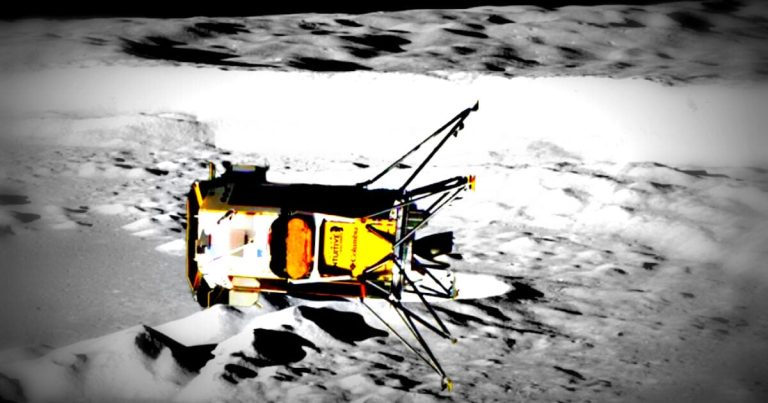
Odysseus reached the surface of the moon in a feat worthy of ancient mythology – but like those ancient epics, many dangers and obstacles had to be overcome.
In the case of the Nova-C lunar lander, it has now emerged that it may have stumbled during landing, and is thought to have now flipped over, resting on its side with its 'head' resting on a rock.
One could almost look at it as a “new trend” in space exploration, after the historic Japanese SLIM lunar lander was turned upside down on the moon's surface and was still able to perform many of its intended missions.

Houston-based Intuitive Machines has assured us that the lunar lander is “alive and well,” one day after it made a “sudden landing” as the first private spacecraft ever to reach the lunar surface — and the first from the United States since 1972.
They revealed human error led to the failure of the spacecraft's laser-based rangefinders. Engineers discovered the defect by chance hours before landing, and improvised an “emergency fix” that saved the mission from a potential accident.
Reuters reported:
“Although Odysseus reached the surface intact on Thursday, analysis of data by flight engineers showed that the six-legged rover apparently tripped over its own feet as it approached the end of its final descent,” company officials said at a news conference the next day. .
The spacecraft is believed to have caught one of its feet on the moon's uneven surface and flipped over, coming to rest sideways, propped on a rock at one end, said CEO Stephen Altemus, whose company built and flew the lander.
Odysseus is “grounded near or at the intended landing site,” near a crater called Malapert A in the moon's south pole region, Altimus told reporters.
“We have communications with the lander, and mission control operators are sending commands to the rover,” Altimos said, adding that they were working on obtaining the first photographs of the lunar surface from the landing site. He described a brief mission status report posted on the company’s website at the time. Earlier on Friday, Odysseus was declared “alive and well.”

All but one of NASA's six science and technology payloads were mounted on parts of the rover that were left exposed and receiving communications, but two antennas were left pointing at the surface, which will limit communications with the lander.
One of the solar panels on top of Odysseus was now facing the wrong direction, but a second array on the side of the spacecraft was working fine, and the spacecraft's batteries were fully charged.
“The unmanned robotic spacecraft reached the lunar surface on Thursday after a final approach and difficult landing as a problem developed in its navigation system, requiring flight controllers on Earth to use an untested workaround to avoid what could have been a disaster.” Catastrophic crash landing.
[…] The spacecraft, which burns propellants of liquid methane and liquid oxygen for the first time in space, “performed flawlessly” during its seven-day journey to and in orbit around the moon, Crane said.
The payloads aboard the lander are expected to operate for about nine or 10 days, after which the sun will set on the polar landing site.
BBC reported:
Steve Altimos, CEO and co-founder of IM, said it wasn't entirely clear what happened but data suggested the robot stuck its foot on the surface and then fell because it still had some lateral movement at the moment of landing. .
Another possibility is that Odysseus broke his leg during his fall. Certainly, inertial sensors indicate that the car body is in a horizontal position.
[…] “We hope to get photos and do a real assessment of the structure and evaluate all the external equipment,” Altimos told reporters. “So far, we have a significant amount of operational capability even though we've flipped. That's really exciting for us, and we're continuing the surface operations mission as a result.”
A US satellite called the Lunar Reconnaissance Orbiter will search for Odysseus this weekend to confirm his whereabouts.
“Once the sun sets on Oddie, the batteries will try to keep the car warm and lively, but they will eventually get too cold and our electronics won't be able to withstand the extreme cold of a lunar night,” said Tim Crane, CTO. “So, in the best-case scenario, we're looking at another nine to 10 days (of operations),” the IM co-founder said.
Read more:
Over the Moon: Indian Prime Minister Narendra Modi celebrates 'fall of the Bastille' with French President Macron, as Chandrayaan-3 mission launches for lunar landing that could make India a major space power

